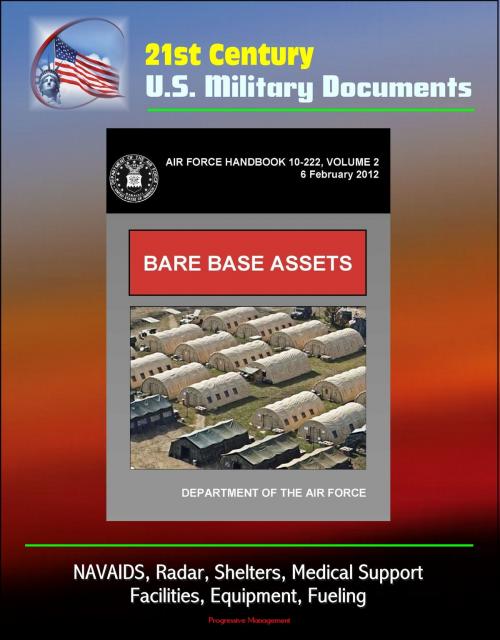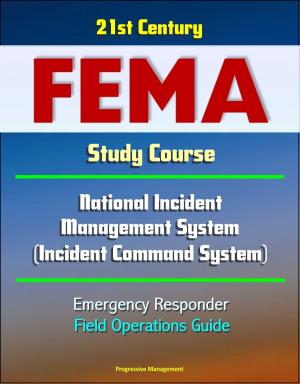21st Century U.S. Military Documents: Bare Base Assets (Air Force Handbook 10-222 Volume 2) - NAVAIDS, Radar, Shelters, Medical Support, Facilities, Equipment, Fueling
Nonfiction, History, Military, Aviation| Author: | Progressive Management | ISBN: | 9781301124244 |
| Publisher: | Progressive Management | Publication: | October 8, 2013 |
| Imprint: | Smashwords Edition | Language: | English |
| Author: | Progressive Management |
| ISBN: | 9781301124244 |
| Publisher: | Progressive Management |
| Publication: | October 8, 2013 |
| Imprint: | Smashwords Edition |
| Language: | English |
This handbook describes Basic Expeditionary Airfield Resources (BEAR) Air Force civil engineers are likely to site, install, or operate in an expeditionary field environment. It provides a brief overview of major systems and equipment, along with applicable technical references.
Long before World War II, leaders in the Army Air Forces recognized the importance of being able to rapidly construct and sustain airfields close to or even behind enemy lines. Over the years, that fundamental understanding of projecting air power precipitated doctrine, organization, training, materiel, leadership and education, personnel, and facilities (DOTMLPF) that continues to evolve today. The Air Force's power projection mission requires that it be able to apply air, space, and cyberspace power anywhere in the world in support of U.S. national interests. In fact, air, space, and cyberspace power can reach across the full spectrum of military operations—from humanitarian assistance missions and stability operations, to the decisive application of air power in support of combat operations around the globe. To that end, the ability to develop a bare base or operating location quickly is an essential part of the USAF power projection mission, and subsequently one of civil engineers' (CE) most important expeditionary and contingency tasks. Like most major construction projects, developing a bare base or operating location to beddown forces require both skilled personnel and suitable materiel to build facilities and infrastructure. Basic Expeditionary Airfield Resources (BEAR) and other assets help fulfill the latter requirement. BEAR is essentially war readiness materiel that is configured and stored ready to deploy. This handbook primarily addresses BEAR assets used during bare base development and force beddown activities. It contains CE tactics, techniques, and procedures (TTPs) that follow the precepts outlined in Air Force Doctrine Document (AFDD) 4-0, Combat Support, and AFDD 3-34, Engineer Operations, and aids in the implementation of Air Force Policy Directive (AFPD) 10-2, Readiness.
Chapter 1 * INTRODUCTION * 1.1. General Information * 1.2. Overview * 1.3. Roles and Responsibilities * 1.4. BEAR Accountability * 1.5. Equipment Packaging and Configurations * 1.6. Equipment Repairs * 1.7. Additional Information * Chapter 2 * SHELTERS * 2.1. General Information * 2.2. BEAR Shelters * 2.3. Legacy Shelters * Chapter 3 * WATER AND SANITATION * 3.1. General Information * 3.2. BEAR Water System * 3.3. BEAR Sanitation Assets * Chapter 4 * MOBILE ELECTRIC POWER AND DISTRIBUTION * 4.1. General Information * 4.2. MEP-805B TQG * 4.3. MEP-806B TQG * 4.4. MEP-012A Prime Power Generator * 4.5. Interim Power Unit * 4.6. Generator Fuel Bladders * 4.7. Electrical Distribution Systems * 4.8. Legacy Power Systems * Chapter 5 * HEATING, VENTILATION, AIR CONDITIONING, AND REFRIGERATION (HVAC/R) * 5.1. General Information * 5.2. Field-Deployable Environmental Control Unit (FDECU) * 5.3. 130K Portable Heater * 5.4. H-1 Heater Unit * 5.5. M-80 Water Heater * 5.6. WH-400 Water Heater * 5.7. Advanced Design Refrigerator, 300 Cubic Foot (ADR-300) * 5.8. TRICON Refrigerated Container System (TRCS) * 5.9. Legacy HVAC/R Systems * Chapter 6 * SPECIALIZED ASSETS * 6.1. General Information * 6.2. Specialized Equipment and Systems * Chapter 7 * NON-BEAR ASSETS * 7.1. General Information * 7.2. Fuels Operational Readiness Capability Equipment (FORCE) * 7.3. Fuels Mobility Support Equipment (FMSE) * 7.4. Fuel Bladders * 7.5. Expeditionary Medical Support (EMEDS) Facilities * 7.6. Aeromedical Staging Facility (ASF) * 7.7. Transportable Blood Transshipment Center (TBTC) * 7.8. Navigational Aids (NAVAIDs) * 7.9. International Organization for Standardization (ISO) Containers * 7.10. Expandable Light Air Mobile Shelter (ELAMS) * 7.11. K-Span Structures * 7.12. Revetments * 7.13. Force Provider Facilities and Equipment
This handbook describes Basic Expeditionary Airfield Resources (BEAR) Air Force civil engineers are likely to site, install, or operate in an expeditionary field environment. It provides a brief overview of major systems and equipment, along with applicable technical references.
Long before World War II, leaders in the Army Air Forces recognized the importance of being able to rapidly construct and sustain airfields close to or even behind enemy lines. Over the years, that fundamental understanding of projecting air power precipitated doctrine, organization, training, materiel, leadership and education, personnel, and facilities (DOTMLPF) that continues to evolve today. The Air Force's power projection mission requires that it be able to apply air, space, and cyberspace power anywhere in the world in support of U.S. national interests. In fact, air, space, and cyberspace power can reach across the full spectrum of military operations—from humanitarian assistance missions and stability operations, to the decisive application of air power in support of combat operations around the globe. To that end, the ability to develop a bare base or operating location quickly is an essential part of the USAF power projection mission, and subsequently one of civil engineers' (CE) most important expeditionary and contingency tasks. Like most major construction projects, developing a bare base or operating location to beddown forces require both skilled personnel and suitable materiel to build facilities and infrastructure. Basic Expeditionary Airfield Resources (BEAR) and other assets help fulfill the latter requirement. BEAR is essentially war readiness materiel that is configured and stored ready to deploy. This handbook primarily addresses BEAR assets used during bare base development and force beddown activities. It contains CE tactics, techniques, and procedures (TTPs) that follow the precepts outlined in Air Force Doctrine Document (AFDD) 4-0, Combat Support, and AFDD 3-34, Engineer Operations, and aids in the implementation of Air Force Policy Directive (AFPD) 10-2, Readiness.
Chapter 1 * INTRODUCTION * 1.1. General Information * 1.2. Overview * 1.3. Roles and Responsibilities * 1.4. BEAR Accountability * 1.5. Equipment Packaging and Configurations * 1.6. Equipment Repairs * 1.7. Additional Information * Chapter 2 * SHELTERS * 2.1. General Information * 2.2. BEAR Shelters * 2.3. Legacy Shelters * Chapter 3 * WATER AND SANITATION * 3.1. General Information * 3.2. BEAR Water System * 3.3. BEAR Sanitation Assets * Chapter 4 * MOBILE ELECTRIC POWER AND DISTRIBUTION * 4.1. General Information * 4.2. MEP-805B TQG * 4.3. MEP-806B TQG * 4.4. MEP-012A Prime Power Generator * 4.5. Interim Power Unit * 4.6. Generator Fuel Bladders * 4.7. Electrical Distribution Systems * 4.8. Legacy Power Systems * Chapter 5 * HEATING, VENTILATION, AIR CONDITIONING, AND REFRIGERATION (HVAC/R) * 5.1. General Information * 5.2. Field-Deployable Environmental Control Unit (FDECU) * 5.3. 130K Portable Heater * 5.4. H-1 Heater Unit * 5.5. M-80 Water Heater * 5.6. WH-400 Water Heater * 5.7. Advanced Design Refrigerator, 300 Cubic Foot (ADR-300) * 5.8. TRICON Refrigerated Container System (TRCS) * 5.9. Legacy HVAC/R Systems * Chapter 6 * SPECIALIZED ASSETS * 6.1. General Information * 6.2. Specialized Equipment and Systems * Chapter 7 * NON-BEAR ASSETS * 7.1. General Information * 7.2. Fuels Operational Readiness Capability Equipment (FORCE) * 7.3. Fuels Mobility Support Equipment (FMSE) * 7.4. Fuel Bladders * 7.5. Expeditionary Medical Support (EMEDS) Facilities * 7.6. Aeromedical Staging Facility (ASF) * 7.7. Transportable Blood Transshipment Center (TBTC) * 7.8. Navigational Aids (NAVAIDs) * 7.9. International Organization for Standardization (ISO) Containers * 7.10. Expandable Light Air Mobile Shelter (ELAMS) * 7.11. K-Span Structures * 7.12. Revetments * 7.13. Force Provider Facilities and Equipment















